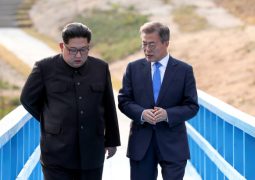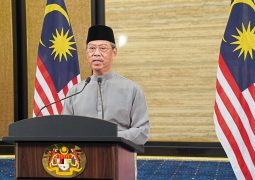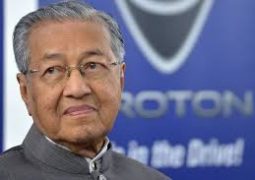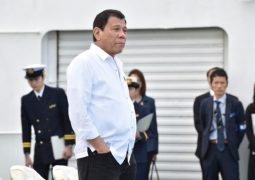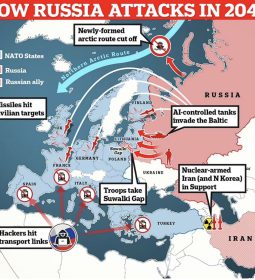North Korea Claims Breakthrough in Missile Technology

SEOUL—North Korea’s latest missile launch is its third apparent breakthrough in missile technology in less than three weeks.
Pyongyang claimed Tuesday that the short-range ballistic missile fired Monday had a speeded-up launch process and a precision-control guidance system that can zero in within 23 feet of a target.
If true, the North’s new capability would mark the third major milestone that North Korea has claimed in less than three weeks. Tuesday’s claim follows the launch of what analysts believe is North Korea’s longest-range functioning missile and the test-firing last week of a solid-fueled missile that requires virtually no preparation time before launch.
North Korean leader Kim Jong Un attended Monday’s test-launch, the state-run North Korean Central News Agency said Tuesday. It said the missile was fired from the back of a “newly designed” launch vehicle.
The missile employed a preparatory launch process that was more highly automated “for markedly reducing the launching time” of its traditional liquid-fueled missiles, Mr. Kim was quoted as saying.
Almost all of North Korea’s missiles use liquid fuel and must be filled at the launch site before firing, a laborious process that makes the missile vulnerable to a pre-emptive strike. North Korea has recently turned to developing solid-fueled missiles that contain the fuel inside and don’t need to be filled beforehand.
But according to North Korea’s latest boast, the liquid-fueled missile tested Monday, which analysts believe to be a variant of a short-range liquid-fueled Scud missile, can now be launched with less lead time.
Also notable were the North’s new claims of precision guidance. The missile featured stabilization systems to regulate speed and altitude, and a warhead with “control wings” that “correctly hit a planned target point with deviation of seven meters,” or 23 feet, the state news agency said.
The missile was first displayed at North Korea’s mid-April military parade in central Pyongyang, the report said, where independent analysts noted the apparently new missile and have provisionally labeled it the KN-17.
The missile, launched at 5:10 a.m. local time Monday from near the east-coast city of Wonsan, reached a maximum altitude of about 75 miles before splashing down six minutes and 280 miles later in the waters between Korea and Japan, according to the U.S. and South Korean militaries.
Monday’s test showed Mr. Kim isn’t throttling back in his drive to perfect his growing arsenal, particularly to develop a long-range missile capable of carrying a nuclear warhead.
The launches are also likely to be a headache for South Korean President Moon Jae-in, who has been riding a wave of popularity since he was sworn in on May 10, ending a political crisis capped by the impeachment and then arrest of his predecessor, Park Geun-hye.
As North Korea continues its missile push, Mr. Moon’s pledge to seek more dialogue and economic cooperation with Pyongyang—Ms. Park was a hard-liner—is likely to run into growing concerns both within South Korea and internationally about a softer policy.
Monday’s test-launch “is an embarrassment for Moon Jae-in, and sets a very high barrier to change on the policy toward North Korea,” said Jung Kim, professor of political science at the University of North Korean Studies in Seoul. “Without at least a behavioral change by North Korea, it’s very hard to justify any kind of departure from the st
U.S. Sen. Cory Gardner (R., Colo.), chairman of the Senate Foreign Relations Committee’s subpanel on East Asia, said Monday evening in Seoul that the missile launches underscored North Korea’s indifference to the new Moon administration’s attempts to pursue engagement with Pyongyang.
“If this administration is willing to take a different path than the previous administration, it apparently doesn’t mean anything to North Korea because we’ve now seen a third missile launch since this president has been inaugurated,” Mr. Gardner said. “It just shows what kind of a regime you’re dealing with.”
U.S. President Donald Trump said on Twitter Monday that “North Korea has shown great disrespect for their neighbor, China, by shooting off yet another ballistic missile.” But he added that “China is trying hard!”—an apparent reference to Beijing’s efforts to tighten sanctions enforcement on North Korea.
Earlier this year, China said it would suspend imports of coal from North Korea, in a move that would deprive the isolated country of a major source of income.
The attempts to squeeze North Korea come as the country has touted new capabilities with its recent launches.
Two weeks ago, Pyongyang test-fired a missile that it later called the Hwasong-12, which analysts said could fly 2,800 miles—considerably farther than its previous missiles, and far enough to reach the U.S. military base on Guam. About a week later came the Polaris-2 missile, fueled by a solid rather than a liquid fuel—meaning it requires much less time to prepare for launch, giving Pyongyang more flexibility and stealth.
Mr. Kim, the North Korean leader, last week declared the Polaris-2—unveiled about three months earlier—“very accurate,” and ordered its mass production, according to North Korea’s state media.
After Monday’s launch, Mr. Kim called for more missile research, which he said would allow the North “to send bigger ‘gift package’ to the Yankees.”
“Whenever news of our valuable victory is broadcast recently, the Yankees would be very much worried about it and the gangsters of the South Korean puppet army would be dispirited more and more,” Mr. Kim was quoted as saying.
In Japan, Chief Cabinet Secretary Yoshihide Suga said the projectile had landed within 200 miles of the nation’s coastline, meaning it had fallen within its exclusive economic zone. “We condemn these actions in the strongest manner,” he said.
“This cannot be tolerated,” said Japanese Prime Minister Shinzo Abe, who told reporters he would work with the U.S. and South Korea to monitor North Korea’s actions.
—George Nishiyama in Tokyo contributed to this article.
- Previous Philippine authorities seize meth shipment worth US$121 million after China tip-off
- Next Mark-III missile lunch planned in India



